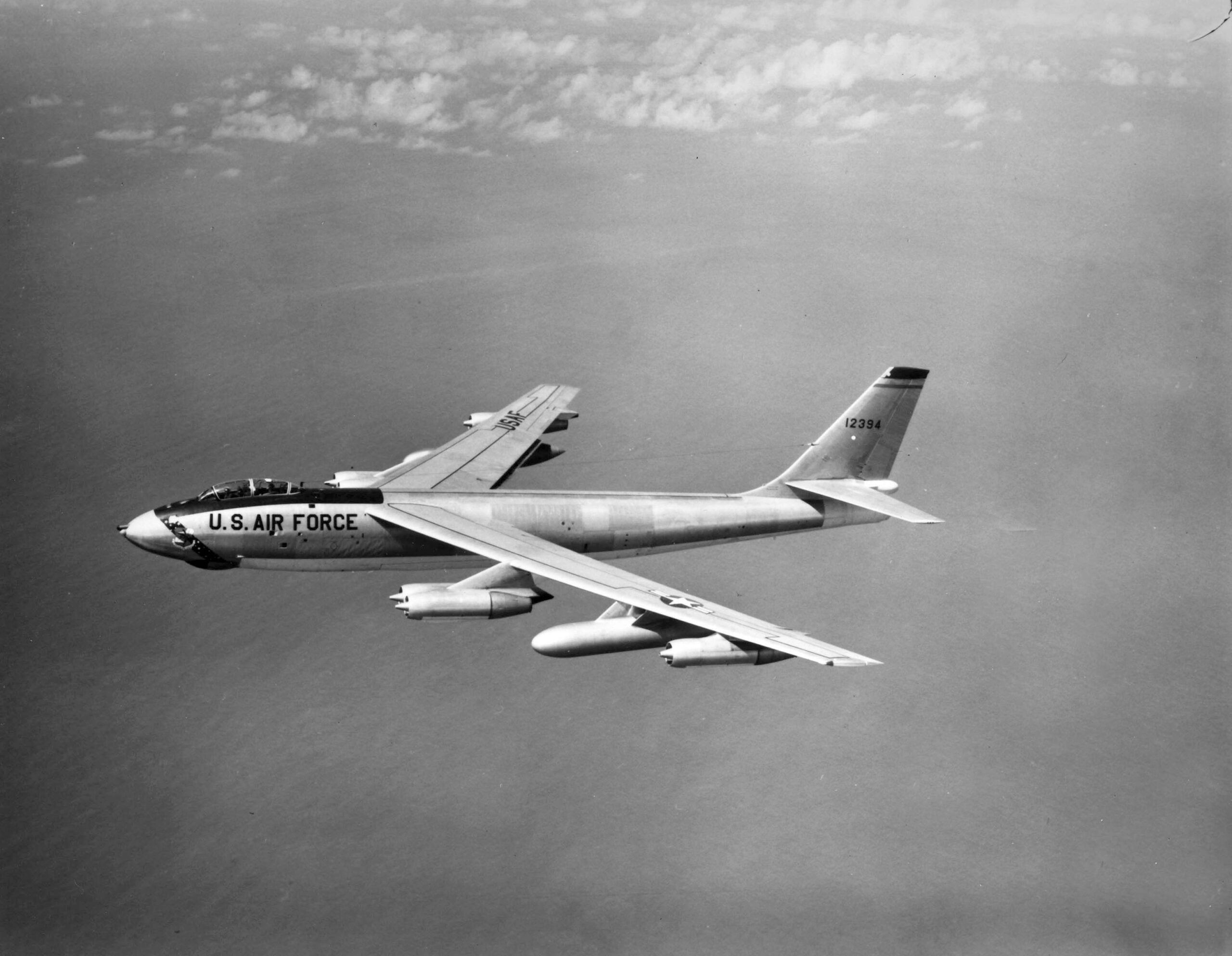
On the night of 4–5 February 1958, two Boeing B-47 Stratojet bombers from MacDill Air Force Base, Florida, were flying a simulated bombing mission. The second bomber, B-47B-50-BW serial number 51-2349, was under the command of Major Howard Richardson, USAF, with co-pilot 1st Lieutenant Bob Lagerstrom and radar navigator Captain Leland Woolard. Their call sign was “Ivory Two.”
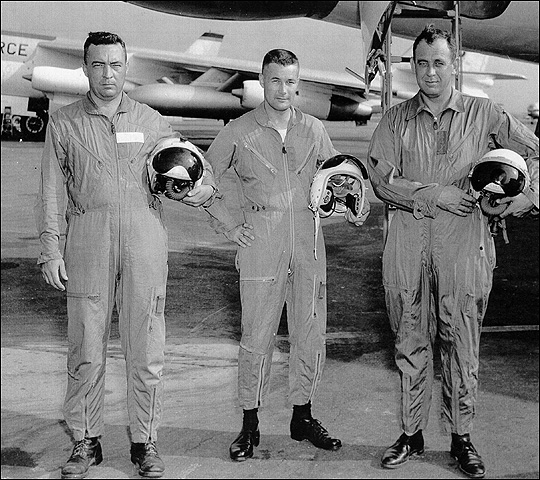
Carried in the bomb bay of Ivory Two was a 7,600-pound (3,448 kilogram) Mark 15 Mod. 0 two-stage radiation-implosion thermonuclear bomb, serial number 47782. The bomb had been developed by the Los Alamos National Laboratory. The Mod. 0 had an explosive yield of 1.69 megatons.¹
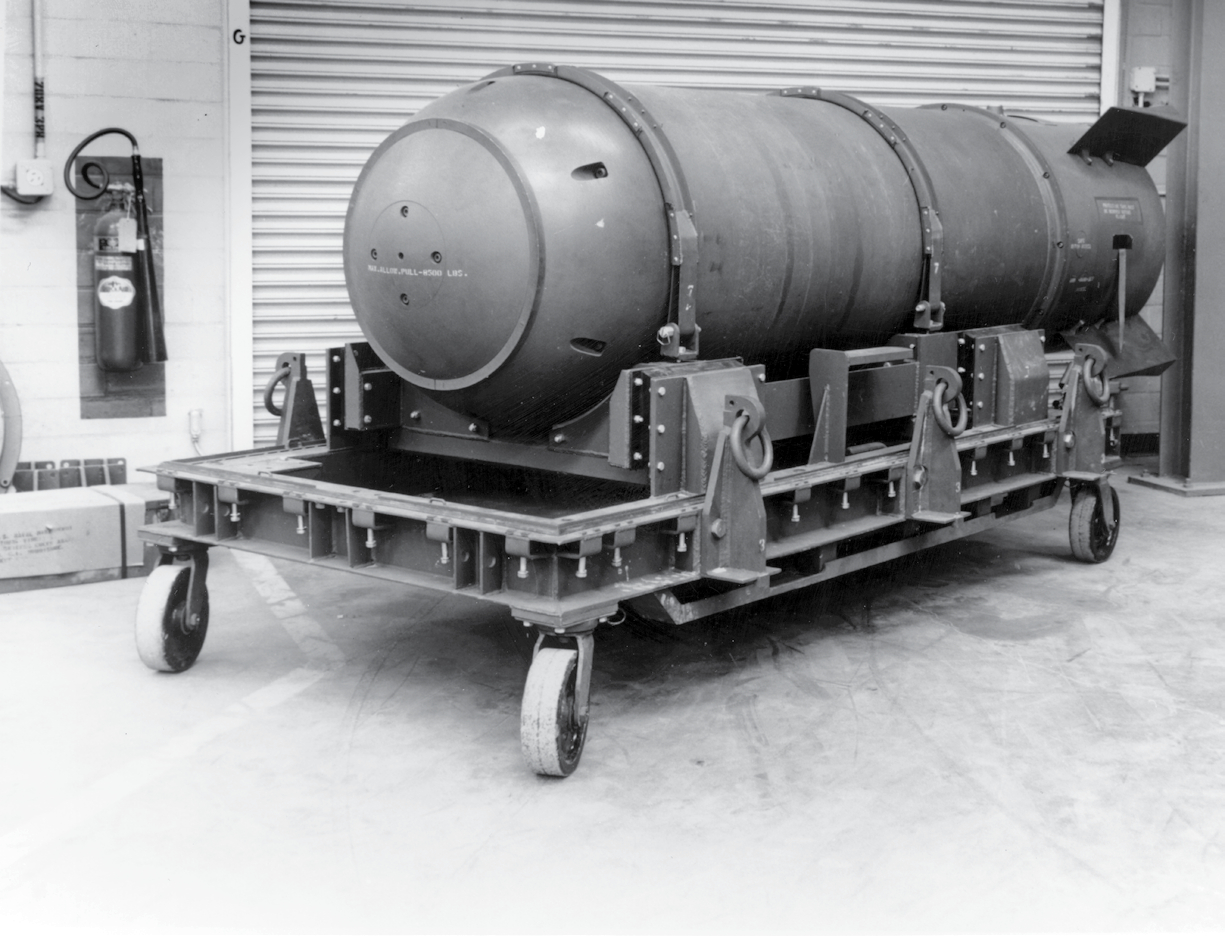
After completing their simulated bombing mission, the B-47s were returning to their base in Florida.
On the same night pilots of South Carolina Air National Guard were on alert at Charleston Air Force Base with their North American Aviation F-86L Sabre interceptors. The fighters were fully armed with twenty-four 2.75-inch (70 mm) rockets. At 00:09 a.m., the pilots were alerted for a training interception of the southbound B-47s. Within five minutes three F-86Ls were airborne and climbing, with air defense radar sites directing them. In one of the F-86Ls, 52-10108, an upgraded F-86D Sabre, was 1st Lieutenant Clarence A. Stewart, call sign, “Pug Gold Two.”
The flight of interceptors came in behind the bombers at about 35,000 feet (10,668 meters). Tracking their targets with radar, they closed on the lead B-47, Ivory One, from behind. Ivory Two was about 1 mile (1.6 kilometers) in trail of Ivory One, but the airborne radars of the Sabres did not detect it, nor did the ground-based radar controllers.
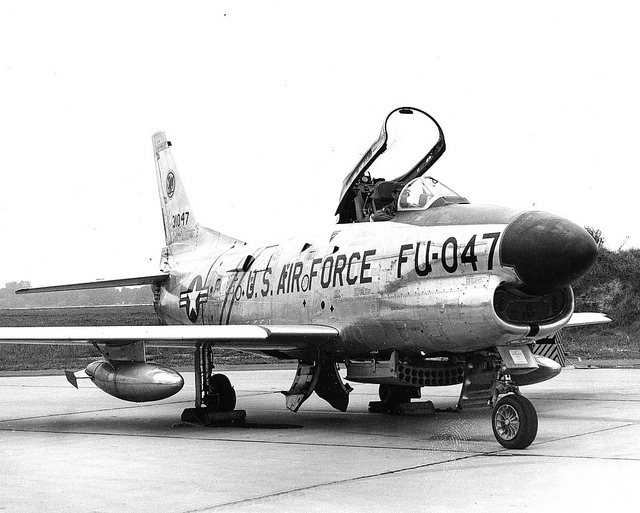
At 00:33:30, 5 February, Lieutenant Stewart’s fighter collided with the right wing of Major Richardson’s bomber. The Sabre lost both wings. Lieutenant Stewart fired his ejection seat. His descent from the stratosphere took twenty-two minutes and his hands were frostbitten from the cold. He spent five weeks in an Air Force hospital. Pug Gold Two crashed in a farm field about 10 miles (16 kilometers) east of Sylvania, Georgia.
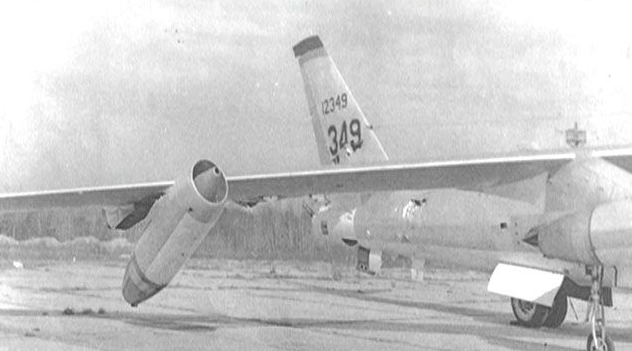
The B-47 was heavily damaged. The outboard engine had been dislodged from its mount on the wing and hung at about a 45° angle. The wing’s main spar was broken, the aileron was damaged, and the airplane and its crew were in immediate jeopardy. The damage to the flight controls made it difficult to fly. If the number six engine fell free, the loss of its weight would upset the airplane’s delicate balance and cause it to go out of control, or the damaged wing might itself fail.
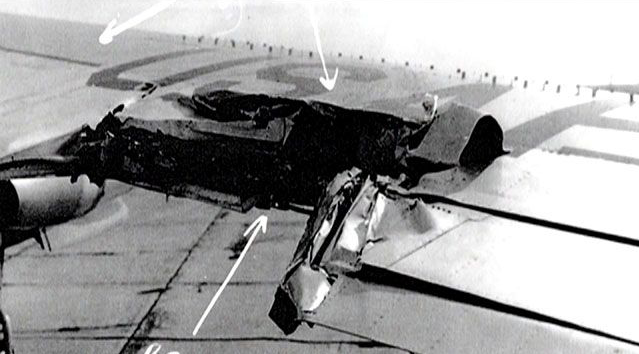
Major Richardson didn’t think they could make it back to MacDill, and the nearest suitable airfield, Hunter Air Force Base, Savannah, Georgia, advised that the main runway was under repair. A crash on landing was a likely outcome.
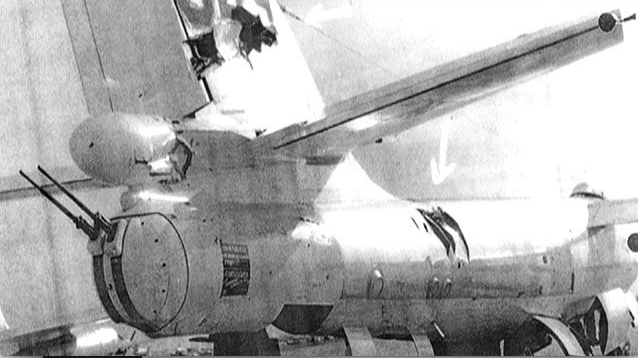
With this in mind, Richardson flew Ivory Two out over Wassaw Sound, and at an altitude of 7,200 feet (2,195 meters) the hydrogen bomb was jettisoned. It landed in about 40 feet (12 meters) of water near Tybee Island. No explosion occurred.
The B-47 safely landed at Hunter AFB, but was so badly damaged that it never flew again. Major Richardson was awarded the Distinguished Flying Cross for his handling of the incident.
The missing Mark 15 has never been found and is considered to be “irretrievably lost.” It is known as “The Tybee Bomb.”
Clarence Arville Stewart was born 17 October 1934 at Drew, Mississippi. He was the son of John B. Stewart and Cleta R. Stewart. Stewart soloed a airplane for the first time at the age of 13 years. By the time he was 15, he had enlisted in the Mississippi National Guard. His actual age was discovered as his unit was preparing to deploy during the Korean War, and he was sent home.
After studying at the Mississippi Delta Community College at Moorehead, Mississippi, Stewart enlisted in the U.S. Air Force as an aviation cadet. On graduation from flight training, he was commissioned as a second lieutenant, United States Air Force Reserve, in 1956.
In 1958, Lieutenant Stewart married Miss Patricia Ann Hudson of Beaufort, South Carolina. They would have three children. Mrs. Stewart passed away in 2010.
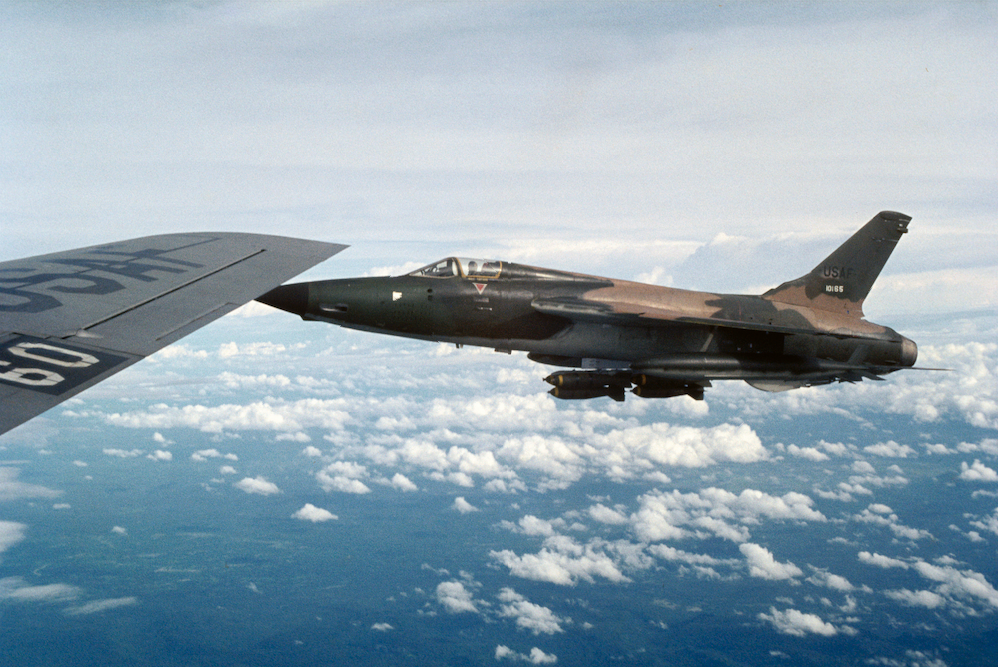
Eight years after the mid-air collision with the B-47, Captain Stewart was in Thailand, assigned to the 421st Tactical Fighter Squadron, 388th Tactical Fighter Wing, based at Korat Royal Thai Air Base. Flying a strike mission on 2 June 1966, the the engine of his Republic F-105D-20-RE Thunderchief, 61-0160, exploded. Stewart ejected from his airplane for the second time in his career. The fighter bomber went down approximately 55 miles (89 kilometers) northeast of Korat. Captain Stewart was picked up by helicopter.
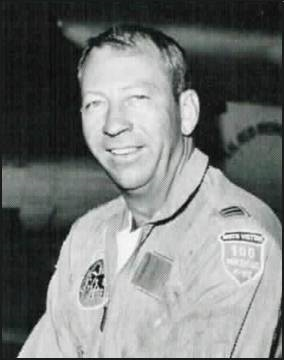
Stewart flew over 100 combat missions over North Vietnam. He was awarded the Silver Star for his actions of 1 August 1966: “While leading a flight of F-105s against an oil storage tank fabrication in North Viet Nam, Capt. Stewart was caught in a deadly cross fire from several SA-2 missile sites. He was turned back from the target three separate times by a total of eight SA-2 surface-to-air missiles, yet he persisted in his attack until his communication equipment was seriously damaged by an exploding missile and his flight had only recover fuel remaining. In the midst of the SAM barrage, Captain Stewart demonstrated his calm and courageous leadership by directing his wingman’s escape from an uprushing missile.” Major Stewart was awarded the Distinguished Flying Cross for another flight in which he destroyed two anti-aircraft sites.
The following year, Major Stewart was assigned as chief of the Aerial Review Control Team based at Eglin Air Force Base. The unit was responsible for controlling air shows, other than those flown by The Thunderbirds. (A junior member of the team was 1st Lieutenant Steve Ritchie, future fighter ace.)
Lieutenant Colonel Stewart retired from the Air Force in 1977. He died at Fort Walton Beach, Florida, 15 January 2015.
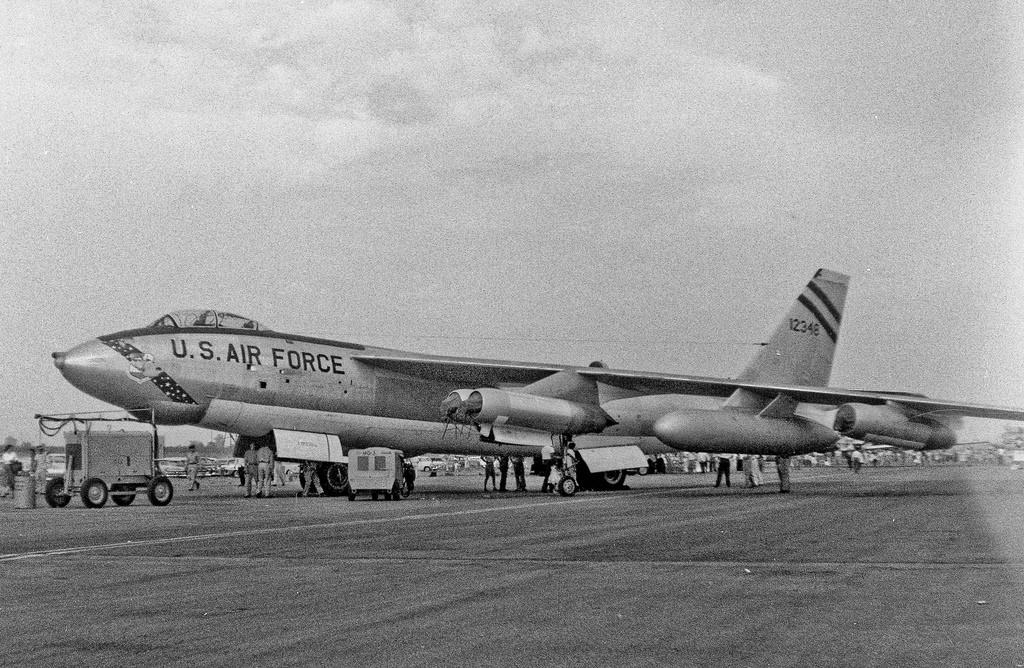

The Boeing B-47B Stratojet was the first full-production model. The B-47B is 106 feet, 10 inches (32.563 meters) long with a wingspan of 116 feet, 0 inches(35.357 meters), and an overall height of 27 feet, 11 inches (8.509 meters). The wings are shoulder-mounted with the leading edges swept aft to 36° 37′. Their angle of incidence is 2° 45′ and there is no dihedral. (The wings are very flexible, showing marked anhedral on the ground and flexing upward when in flight.) The B-47B has an empty weight of 78,102 pounds (35,426 kilograms), and a maximum takeoff weight of 185,000 pounds (83,915 kilograms). The maximum in-flight weight (after air refueling) was 221,000 pounds (100,244 kilograms).
From 1953 to 1957, the B-47B fleet underwent an extensive modification program which brought them up to the B-47E configuration.
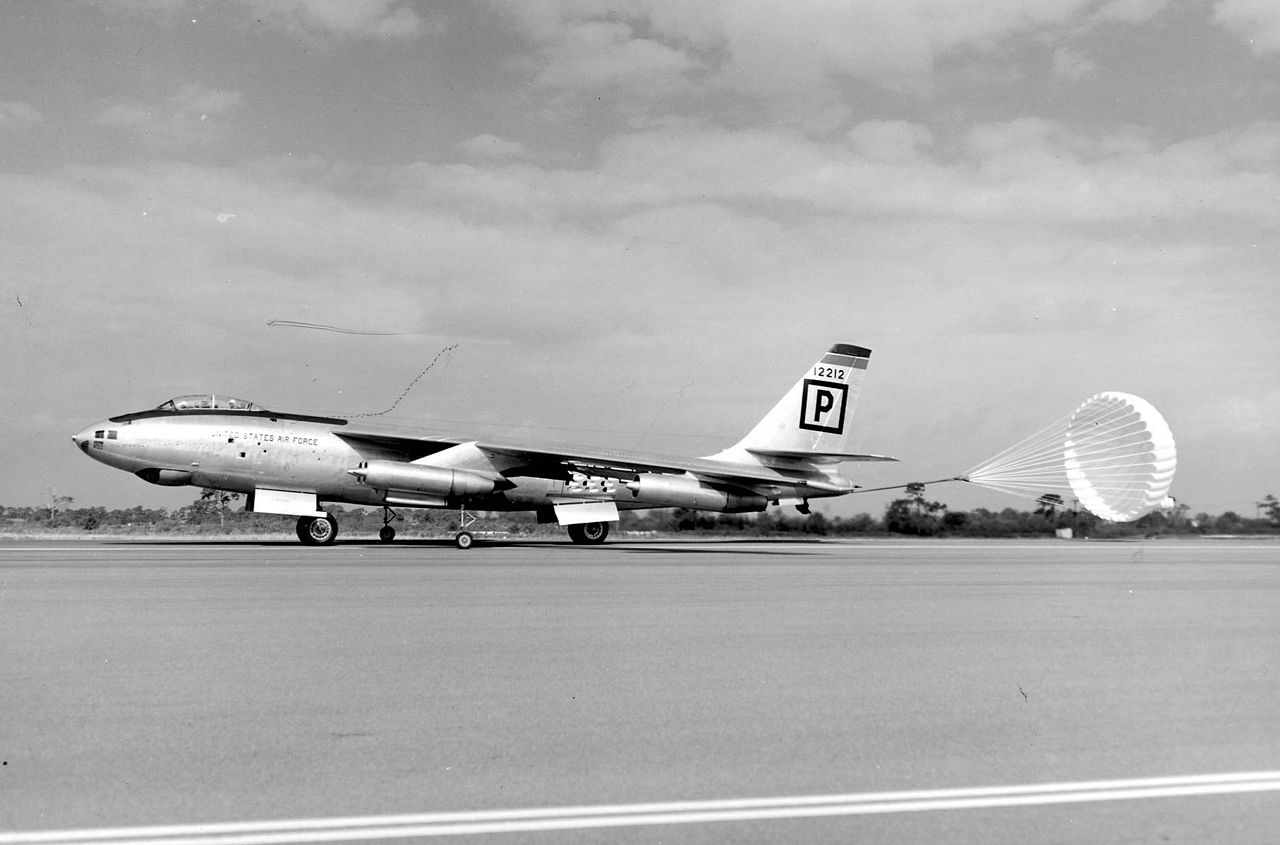

The B-47B was also equipped with solid-fuel rocket engines (JATO) located in the aft fuselage. These produced a maximum 33,000 pounds of thrust (146.8 kilonewtons) for 14 seconds.
The B-47B Stratojet had a cruise speed of 433 knots (498 miles per hour/802 kilometers per hour), and maximum speed of 528 knots (608 miles per hour/978 kilometers per hour) at 16,300 feet (4,968 meters). The service ceiling was 42,100 feet (10,333 meters) and combat ceiling 40,800 feet (12,436 meters).
The combat radius of the B-47B was 1,704 nautical miles (1,961 statute miles/3,156 kilometers with a 10,000 pound (4,536 kilograms) bomb load. Two jettisonable underwing fuel tanks could carry 1,780 gallons (6,738 liters) each. The maximum ferry range was 3,861 nautical miles (4,443 statute miles (7,151 kilometers).
For defense the B-47B was armed with two Browning AN-M3 .50-caliber machine guns in a remotely-operated tail turret, with 600 rounds of ammunition per gun. The co-pilot acted as the gunner using an optical sight. The machine guns were replaced by two M24A1 20 mm autocannons and radar control.
The maximum bomb load of the B-47B was 18,000 pounds (8,165 kilograms). The B-47 could carry two 7,600 pound (3,447 kilogram) Mark 15 two-stage radiation implosion thermonuclear bombs, each with an explosive yield of up 3.8 megatons, depending on the version, or a single 10,670 pound (4,808 kilogram) B-41 three-stage, 25 megaton bomb.
Beginning in 1953, the B-47B fleet underwent an extensive modification program which brought them up to the B-47E configuration.
A total of 2,032 B-47s were built by a consortium of aircraft manufacturers: Boeing Airplane Company, Wichita, Kansas; Douglas Aircraft Company, Tulsa, Oklahoma; Lockheed Aircraft Company, Marietta, Georgia. 399 of these were B-47Bs.
The Stratojet is one of the most influential aircraft designs of all time and its legacy can be seen in almost every jet airliner built since the 1950s: the swept wing with engines suspended below and ahead on pylons. The B-47 served the United States Air Force from 1951 to 1977. From the first flight of the Boeing XB-47 Stratojet prototype, 17 December 1947, to the final flight of B-47E 52-166, was 38 years, 6 months, 1 day.
¹ The Mark 15 Mod. 0 prototype, the Zombie device, was tested in Operation Castle, Test Nectar, 13 May 1954, at Enewetak Atoll in the Marshall Islands. A video of the detonation can be seen at:
© 2023, Bryan R. Swopes
I first saw this plane in 1957 in Omaha, at the SAC Base since our house (on base housing is close to the Runway) and it would takeoff right off across the street from the house which has 5 families in the building.
My Dad was Part of SAC and retired after 30 years as a Major.
Bryan – the damage pictures are all labeled as damage tot eh left wing – but that’s only as you look at it in the images. The damage was tot he aircraft’s right wing using standard terminology.
Thanks. Of course, you are right. Dumb mistake. :/
Great historical article. My first online assignment with the USAF, was at Little Rock AFB. As a young Airman I was in the cockpit doing work on the avionics when I felt and heard a swoosh. I exited the aircraft very quickly. Reaching the tarmac i observed one of the engines on fire. Everyone on the ground was running like turkeys. Activating a nearby extinguisher I extinguished the fire. This action resulted in minimal damage to the aircraft. Note: I never wanted nor received any recognition for my actions. I sure loved that B-47. Spent over 21 years with the USAF.
another great story. Thanks Bryan
First saw the B-47’s a kid in dependents school, RAF Upper Heyford, England, ’58. (Dad was an NCO at a nearby radio base.) I joined the USAF 5 years later, and the first planes I worked on were B-47’s, even though I had been trained on the B-52. Sad to see them go.
I was on a weapons load grew and we loaded nukes on B-47s at Lincoln AFB Neb 1964-65
I was a Nuke Weapons Fuzing Systems Specialist at Hunter AFB 56 to mid 59. I was there when this happened and the aircraft sat there for a long time before it was scrapped. Worked on many MK 15’s to make them ready and every time Khruchev looked crosseyed, we loaded 30 or more along with other many SAC bases. General Lemay was in charge of the USAF and not to be toyed with. We kept him at bay during the Cold war.
Was it SOP to fly training missions with nuclear bombs?
No. Not after that incident. I was in the 340th BW (Whiteman) and logged 1500 hrs. in the B-47 from 1958-63. Only twice did our crew carry an airborne “nuke.” Once on deployment to Spain, we carried a nuke, but the trigger or core was not in the weapon. The other time, during the CMC of ’62, we were dispersed to Lambert Field, St. Louis and the core was installed. We were fully armed and ready to go. SAC was under DEFCON two.
I remember loading live nukes on both the B47 and B52 and watch then taxi out and take off. This was back in the late 50’s and early 60’s. Never so glad to change career fields and go to EOD school. Was TDY to Guam as a loading team chief on B52’s loading iron bombs.
In the 6 month period, my crew loaded 7008 bombs and they all dropped, no hangers. Had a Security Policeman on my crew whose job was to check out each bomb rack and he gets all the credit. My memory is all shot and I can’t remember any names except Keith Mowrey, and that’s because someone goosed him and he karate chopped my hand and broke my little finger. Still have a twisted little finger. Good
I was a B-47-E Crew Chief then, 375th Bomb Sqd, Medium, 308th Bomb Wing at Hunter on that eventful morning and had an opportunity to look that bird over, as it was parked near (my) A/C. Those crews were lucky to survive their experience. The photos don’t do justice to the damage that I recall. We were not permitted cameras on the line, so I have only memories. Several days later the remains of the F-86 arrived at Hunter on a flatbed, a jumble of cables and wires, bits and pieces of aircraft and the engines turbine wheel.
That’s not the only Nuke we lost in that era, one landing in the Carolinas near some buildings resulted in extensive mods to the bomb release system and cables in the bomb bays. Another not so serious, the two outrigger landing gear locks were stored on a rack in the bomb bay, they would come loose during flight and fall down on the bomb doors. When simulated bomb runs were done, the doors cycled and you guessed it, out went the outrigger lock. One was found imbedded in the pavement of a Georgia city street intersection. Those locks were two-foot-long thick-walled aluminum pipes, pointed on one end with a streamer on the other.
The Mk 15 Mod 0 bomb did not contain a nuclear capsule, only a lead training capsule in a “birdcage” in the cockpit. It could not be installed into the weapon while the aircraft was in flight (the tail would have to be removed by a trained nuclear weapons team on the ground). Declassified AEC documents show that the capsule was lead and signed by the aircraft commander (who was the custodian).
A nuclear detonation is not possible.
This would explain why they didn’t make more of an effort to find it. Thank goodness!
For more reading on this incident:
https://b-47.com/wp-content/uploads/2012/01/Broken-Arrow-Two.pdf
And summary report:
https://b-47.com/wp-content/uploads/2012/01/Broken-Arrow-USAF-Report.pdf
Thank you, Steve. Interesting reading.